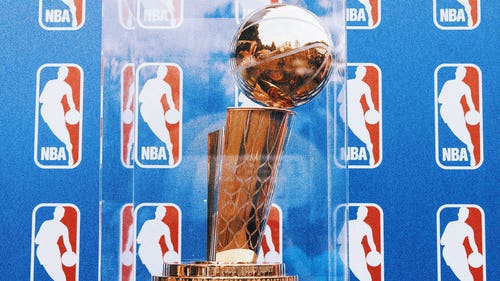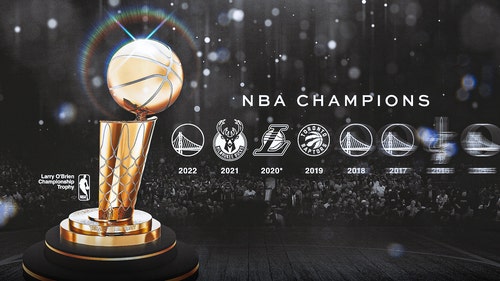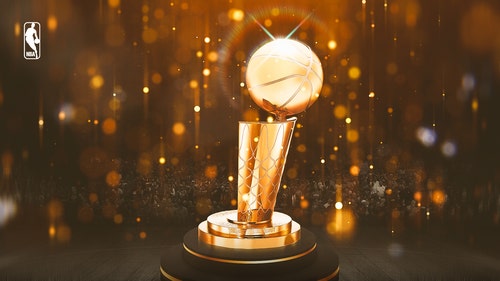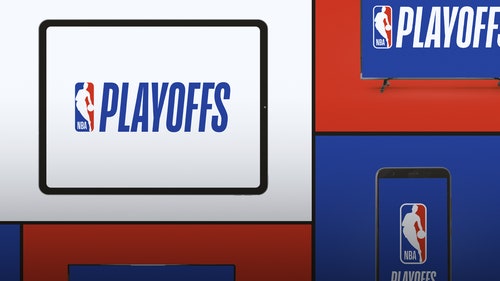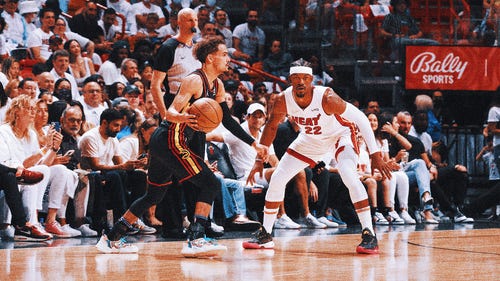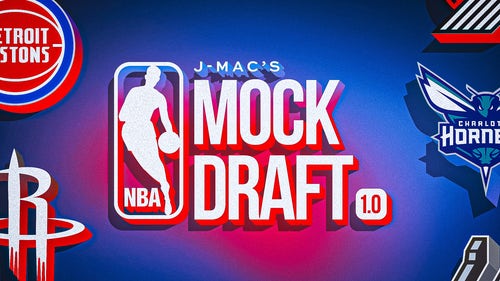
NBA Awards Watch: Gauging The Races Through December
May 11, 2016; Oakland, CA, USA; NBA commissioner Adam Silver (left) presents Golden State Warriors guard Stephen Curry (30, right) the MVP trophy before game five of the second round of the NBA Playoffs against the Portland Trail Blazers at Oracle Arena. Mandatory Credit: Kyle Terada-USA TODAY Sports
With 2016 in the books, it’s time to get serious about the NBA awards. Who are the frontrunners in the race for MVP and the other hardware to be handed out in New York on June 26?
While the hottest takes regarding NBA awards have the MVP trophy handed out 12 times before halftime on opening night in October, some of us prefer the slower, more patient approach (I know, bor-ing!!!!) to figuring out where the hardware should go during the NBA Playoffs at the NBA Awards Show on June 26 in New York.
With the midway point of the season approaching and the 2016 portion of the season now in the books, it’s a good time to get serious about looking at the contenders and frontrunners for Coach of the Year, Most Improved Player, Sixth Man of the Year, Rookie of the Year, Defensive Player of the Year and … of course .. Most Valuable Player.
In the process, the methodology for the selections will be explained. As is the case with everyone with a real vote for these awards, my criteria for selection will differ from yours and those of others. Since the NBA leaves the definitions amorphous, at best, (or in some cases, nonexistent), ultimately these become judgment calls.
This will be the first of four looks at the awards races, with monthly views coming again at the end of January, February and March.
With each of the awards, we’ll focus on my top three contenders and name a few others that should be in the conversation.
Dec 15, 2016; Phoenix, AZ, USA; San Antonio Spurs head coach Gregg Popovich against the Phoenix Suns at Talking Stick Resort Arena. The Spurs defeated the Suns 107-92. Mandatory Credit: Mark J. Rebilas-USA TODAY Sports
Coach of the Year
Probably the award that goes mostly by gut feeling and watching which coach is getting the most from the least and which coach is doing the best job.
There’s been sort of a trend in recent years to default the trophy to the coach of the team with the best record (i.e, Steve Kerr of the Golden State Warriors last season, Gregg Popovich of the San Antonio Spurs in 2011-12 and 2013-14 come immediately to mind), but there are three coaches out there this season that have stood out as exemplary over the first two months.
In the conversation: Jason Kidd, Milwaukee Bucks; Dwane Casey, Toronto Raptors; Tyronn Lue, Cleveland Cavaliers.
3. Gregg Popovich, San Antonio Spurs
Gregg Popovich has the San Antonio Spurs at 27-6 heading into the New Year, second-best in the NBA, despite having to make some major transitions this season.
More from Hoops Habit
The biggest of those was dealing with not having the team’s unquestioned leader, Tim Duncan, for the first time since 1997.
Another has been adapting to the diminishing skills of former NBA Finals MVP Tony Parker, once the heartbeat of the club on the floor, but now a 34-year-old who has appeared in just 24 of the team’s 33 games and is averaging 10.5 points and 4.4 assists a night.
Reserve point guard Patty Mills is actually outscoring Parker at 10.8 points per game despite less playing time (22.6 minutes to Parker’s 25.5 per game).
The sometimes less-than-smooth pairing of incumbent big man LaMarcus Aldridge with free-agent addition Pau Gasol has been another challenge for Pop.
But his steady hand–and the excellence of Kawhi Leonard–has kept San Antonio rolling right along.
2. David Fizdale, Memphis Grizzlies
This was the season the Memphis Grizzlies‘ run in the top tier of the Western Conference was supposed to end.
David Fizdale was getting his first NBA head-coaching opportunity after 13 seasons as an assistant, including the last eight with the Miami Heat, but was inheriting a Grizzlies team that was too old and too thin to remain competitive.
grizzlies
Beale Street Bears 23hGrizzlies set franchise record for three-pointers in a game
More headlines around FanSided:
1 d - Into the Bears' Den: NBA surprises, disappointments, what to expect in 20171 d - Highs and Lows: Sacramento Kings Lose Rough One To Grizzlies1 d - Memphis Grizzlies: Top 5 moments of 20162d - Sacramento Kings: Game 33 Preview vs Memphis Grizzlies2d - Prediction: Sacramento Kings’ Box Score Game 33 vs Memphis GrizzliesMore News at Beale Street Bears
Despite losing point guard Mike Conley for 12 games with a back injury, Zach Randolph (now a sixth man) for seven so the power forward could attend to the death of his mother and only having free-agent pickup Chandler Parsons available for 11 games so far, Fizdale has Memphis right in the thick of things.
The formula looks familiar–the Grizzlies are 22nd in offensive efficiency and lead the NBA with a defensive rating of 103.4 points per 100 possessions. It’s a new spin on the old Grit ‘n’ Grind.
Only, he’s unleased center Marc Gasol from three-point range. In his first eight NBA seasons, Gasol attempted 66 three balls and made 12, a less-than-stellar 18.2 percent rate. This season, Gasol is hitting 41.5 percent, an astonishing 49-for-118 already, and is averaging what would be a career-best 19.5 points per game.
That may be the biggest difference from 2015-16. Memphis attempted 18.5 three-pointers per game, 25th in the NBA, last season and hit 33.1 percent (second-worst in the league). This season, they are taking 25.5 a night (11th-most in the Association) and hitting 34.6 percent (21st).
But Fizdale has the Grizzlies where few thought they’d be–in the hunt for yet another playoff berth out West.
1. Mike D’Antoni, Houston Rockets
Mike D’Antoni is now 12 years removed from his last run as an NBA coaching genius, when he was named Coach of the Year after taking the Phoenix Suns to a 62-20 record in 2004-05 by introducing the Seven Seconds or Less offense.
Less-than-successful stops in New York and Los Angeles damaged his reputation and by last season, he was sitting next to Brett Brown as an assistant for the woeful Philadelphia 76ers.
rockets
Sir Charles In Charge 1 dNBA: 10 Bold Predictions For The 2017 Basketball Year
More headlines around FanSided:
1 d - Houston Rockets Spoil Knicks' New Years' Eve1 d - Game Day: Houston Rockets vs the Knicks1 d - Why can't Ryan Anderson make shots in the Toyota Center?2d - Houston Rockets take advantage of short handed Clippers2d - Houston, We Don't Have A ProblemMore News at Space City Scoop
Until Daryl Morey, the general manager of the Houston Rockets, stunned the NBA by hiring D’Antoni last offseason to take over the head-coaching reins.
There was no shortage of skeptics regarding D’Antoni’s fit in Houston.
But after turning James Harden loose at the point guard spot and taking a roster that few thought could do much of anything (Eric Gordon? Ryan Anderson? The remnants of Nene Hilario? Clint Capela starting at center? Seriously?), D’Antoni has the Rockets flying high at 26-9, third in the Western Conference.
Even with Capela out with a fractured fibula, Houston has rolled right along, getting solid minutes from Nene and Montrezl Harrell in his stead.
Sam Dekker has emerged as a solid rotation player in his second season, Gordon is thriving as a sixth man and Anderson is adapting as a starter at the 4.
And they are not shy about taking threes. The Rockets average 39.7 attempts per game–only a smidgen more than the current NBA record of 32.7 attempts per game set by the 2014-15 Rockets (and by “smidgen” I mean seven freaking attempts a night!).
Dec 31, 2016; Chicago, IL, USA; Milwaukee Bucks forward Giannis Antetokounmpo (34) dunks against the Chicago Bulls during the first half at United Center. Mandatory Credit: Patrick Gorski-USA TODAY Sports
Most Improved Player
Almost from its inception in the 1985-86 season, the Most Improved Player award has been surrounded by confusion about what it really represents.
As often as not, the award is given to a player who didn’t as much improve as he did get more opportunities to play, producing at roughly the same rate as he did before, but with a sharp increase in per-game numbers because he went from averaging 10 to 35 minutes a night.
Some folks want to lump Portland Trail Blazers shooting guard C.J. McCollum into that category, because his MIP honor in 2015-16 coincided with an increase in playing time from 15.7 to 34.8 minutes per game.
But per-36 minutes, McCollum also improved from 15.7 points and 2.4 assists to 21.6 and 4.4, respectively, while his shooting line went from .436/.396/.699 to .448/.417/.827.
Those shooting numbers increased despite going from 13.5 shot attempts per 36 minutes to 18.5, from 5.1 three-point attempts to 6.1 and from 2.7 free-throw attempts to 2.9. For good measure, his Player Efficiency Rating (not the be all and end all, but still an effective tool) jumped from 13.1 to 17.7.
The per-36 minutes and efficiency are key factors in measuring year-over-year improvement and played big roles, along with–of-course–what we see on the court. And to be on the list, a player can’t be returning to past form or near past form.
Kevin Love of the Cleveland Cavaliers, for instance, is having a huge spike in his numbers over 2015-16, but he’s not at the same per-36 levels he was at while with the Minnesota Timberwolves, so it’s hard to call him “most improved.”
Here are the Most Improved Player leaders through December.
In the conversation: Serge Ibaka, Orlando Magic; Jabari Parker, Milwaukee Bucks; Otto Porter, Washington Wizards.
3. Rudy Gobert, Utah Jazz
Now in his fourth season, Rudy Gobert continues to make strides for the Utah Jazz. In 34 games so far this season, Gobert is averaging a double-double–12.5 points and 11.9 rebounds–in 33.0 minutes per game on ridiculous (and league-leading) 70.1 percent shooting from the floor.
Per-36, those numbers expand to 13.6 points and 13.0 rebounds, with 2.8 blocks thrown in for good measure. That’s up from his per-36 figures in 2015-16 of 10.4 points and 12.4 rebounds and a field goal percentage of 55.9 percent.
Gobert has learned what he does well and does that, taking a whopping 98.9 percent of his shots from inside of 10 feet and 85.4 percent from three feet and in. He’s made 77 dunks already and those account for 42.2 percent of his attempts.
Hey, when you’re 7-foot-1 and 245 pounds, play to your strengths. Gobert is doing that, serving as the anchor in the middle for the 21-13 Jazz, who appear poised to end a playoff drought that stretches back to 2012.
2. Myles Turner, Indiana Pacers
Myles Turner looks like a bigger and bigger steal at No. 11 overall by the Indiana Pacers in the 2015 NBA Draft.
After a solid, but injury-shortened, rookie season, Turner has turned it up a notch in his second campaign, averaging 15.3 points, 7.2 rebounds and 2.5 blocks per game on .532/.365/.800 shooting in 29.5 minutes a night for the 16-18 Pacers, helping keep Indiana afloat in the playoff race in the East.
That is up from averages of 10.3 points, 5.5 rebounds and 1.4 blocks on a .498/.214/.727 slash line as a rookie. He averaged only 22.8 minutes per game in 2015-16, so his per-36 increases aren’t quite as dramatic (16.3 points, 12.1 rebounds, 3.1 blocks to 18.6 points, 12.0 rebounds and 4.1 blocks).
But the increased shooting efficiency is eye-opening. He came out of Texas with a reputation as a future stretch-type player, but was just 3-for-14 from long-range as a rookie. Turner is scratching the surface of that potential now, already hitting 19-of-52 from outside the arc in 2016-17.
Turner has also gotten better in the restricted area (from 69 percent last season to 70.9 percent thus far this season) and at the mid-range (hitting 50.5 percent from 16 feet out to the three-point line, up markedly from 42.5 percent last season).
His PER has increased from 15.4 to 20.1, as well, and his block percentage of 7.2 is the best in the NBA.
1. Giannis Antetokounmpo, Milwaukee Bucks
What Giannis Antetokounmpo did after the All-Star break last season set the table. Even so, the explosion that has ensued this season was more than anyone dared to expect.
In 28 games after the break last season, the Greek Freak averaged 18.8 points, 8.6 rebounds, 7.2 assists, 1.9 blocks and 1.4 steals in 36.5 minutes per game on .502/.247/.746 shooting.
While he still doesn’t have much of a consistent jumper, certainly not from three-point range, Antetokounmpo is doing just fine, thanks.
Continuing to man the point guard spot on offense for the 16-16 Milwaukee Bucks, the 6-foot-11 athletic marvel is putting up 23.8 points, 8.9 rebounds, 5.9 assists, 2.0 steals and 2.0 blocks in 35.0 minutes per game while shooting .536/.293/.788.
The last two averages are significant. Only three players–Hakeem Olajuwon (four straight times from 1987-88 through 1990-91), David Robinson in 1991-92 and Gerald Wallace in 2005-06–have ever averaged two steals and two blocks per game in a season.
Dec 9, 2016; Los Angeles, CA, USA; Los Angeles Lakers guard Lou Williams (23) defended by Phoenix Suns forward Alan Williams (15) during a basketball game at Staples Center. Mandatory Credit: Kirby Lee-USA TODAY Sports
Sixth Man of the Year
The winner of the Sixth Man of the Year has never come from a team with a losing record since the award was introduced in 1982-83.
So apparently quality reserve play is only reserved for teams with 42 or more victories, an interesting phenomenon to be sure. Oddly, a team’s record is not a consideration when I review top reserves.
Eligibility for the award is fairly simple–come off the bench more often than you start. Among players who have performed in both roles through December, Nikola Jokic of the Denver Nuggets, Nikola Vucevic of the Orlando Magic and Ersan Ilyasova and Jahlil Okafor of the Philadelphia 76ers are disqualified for this reason.
In the conversation: Kenneth Faried, Denver Nuggets; Terrence Ross, Toronto Raptors; Jon Leuer, Detroit Pistons.
3. Dwight Powell, Dallas Mavericks
In what has been a lost season for the Dallas Mavericks, reserve big man Dwight Powell has been one of the few bright spots.
Powell is averaging 7.8 points, 5.1 rebounds and 1.2 steals in 21.2 minutes a game off the bench for Dallas (he’s started one game in 34 appearances) and is shooting .538/3-for-13/.757.
He’s logged one double-double this season, that coming in his most recent game, Dec. 30 at Golden State. In 26 minutes, Powell was 5-for-7 from the floor and finished with 10 points and 13 rebounds while also blocking two shots.
He’s scored in double figures in his last three games, scoring 13 in a loss to Houston on Dec. 27 and 14 in a win at the Lakers on Dec. 29.
Per-36, Powell’s averages work out to 13.3 points, 8.6 rebounds, 2.0 steals and 1.0 blocks, with a 19.1 PER.
He’s not a traditional Sixth Man of the Year candidate, but for a club that is tied for the worst record in the Western Conference at 10-24, he’s showed up to work every day and has made himself a rotation player with value after coming from the 45th overall draft spot in 2014.
2. Patty Mills, San Antonio Spurs
Patty Mills is in his eighth NBA season and, at age 28, is defying the odds by continuing to improve.
Mills is averaging 10.8 points and 3.5 assists in 22.6 minutes per game–all of which would be career highs–this season for the San Antonio Spurs as the backup to aging Tony Parker at the point guard spot, doing it on .485/.435/.932 shooting (also all the best rates of his career thus far).
A Sixth Man of the Year Award would be a nice addition to take into unrestricted free agency this summer, as well. Mills is in the final season of the three-year, $11 million deal he signed shortly after helping San Antonio win its fifth title in 2014.
Mills is also at a career-best pace with an 18.0 PER and while his per-36 numbers are not at his top levels at 17.2 points, 5.6 assists, 3.0 rebounds and 1.4 steals, they’re being achieved in far more playing time than those previous marks were (22.6 minutes per game against just 16.3 in 2011-12).
With voters, he may be the front-runner as the only guy from a winning club on the list.
1. Lou Williams, Los Angeles Lakers
Lou Williams, whether the Los Angeles Lakers are 12-24 or not, has been the best bench guy in the NBA this year.
Averaging 18.6 points, 3.2 assists, 2.4 rebounds and 1.3 steals in 25.1 minutes per game for the Lakers, Williams is also never been more efficient, shooting at .442/.368/.870 and on a career-high pace with a 23.4 PER.
Williams is a former Sixth Man winner, claiming the honor in 2014-15 when he was with the Toronto Raptors, which could give him some familiarity with the voters (provided they are not still under the spell of Jamal Crawford).
His per-36 numbers are out of this world at 26.7 points, 4.6 assists, 3.4 rebounds and 1.9 steals and the 30-year-old former prep-to-pro player has drawn praise from new coach Luke Walton and others for his veteran leadership on the young club.
Dec 7, 2016; Atlanta, GA, USA; Miami Heat guard Rodney McGruder (17) drives to the basket against Atlanta Hawks guard Tim Hardaway Jr. (10) during the first half at Philips Arena. Mandatory Credit: Dale Zanine-USA TODAY Sports
Rookie of the Year
This one’s another easy one to explain: the best first-year player gets the trophy.
This year’s race has turned into a runaway, even if the “rookie” in question was on an NBA roster for two full seasons before making his official NBA debut this season.
Timing is, it seems, everything. Julius Randle of the Los Angeles Lakers played eight minutes of the opening game in 2014-15 before breaking his leg and that constituted his rookie season.
Joel Embiid, on the other hand, was sidelined by recurring foot problems and didn’t play an official game until this season despite being drafted the same year as Randle and, as such, is a rookie in 2016-17.
It’s probably a good thing, in the broader picture, because without Embiid, the rest of the rookie class makes Michael Carter-Williams‘ “well, someone has to get the damn thing” ROY win in 2013-14 look like the second coming of 1960-61 Oscar Robertson.
In the conversation (because someone has to be): Jamal Murray, Denver Nuggets; Andrew Harrison, Memphis Grizzlies; Dorian Finney-Smith, Dallas Mavericks.
3. Rodney McGruder, Miami Heat
Rodney McGruder is a well-traveled rookie, who endured four years of NBA Summer League action for three different teams, three training camps with three NBA franchises, parts of two NBA D-League seasons with two different teams and a season in Hungary before landing with the Miami Heat this season.
The 25-year-old was undrafted out of Kansas State in 2013 and was a preseason cut by the Oklahoma City Thunder in 2013 and the Boston Celtics in 2014.
He spent his first professional season with Atomeromu SE in Hungary’s NBIA in 2013-14 and split the 2014-15 D-League campaign between the Maine Red Claws and Sioux Falls Skyforce before playing all of 2015-16 in Sioux Falls.
McGruder has started 17 of the 30 games he’s appeared for Miami this season, averaging 5.8 points and 3.5 rebounds in 25.6 minutes per game on .398/.321/.724 shooting.
He scored his career-high of 14 points on Nov. 12 in a loss at home to the Utah Jazz, going 5-of-6 from the floor and hitting 3-of-4 from behind the arc in 22 minutes.
2. Malcolm Brogdon, Milwaukee Bucks
Malcolm Brogdon made a splash in just his second NBA start, lighting up the Chicago Bulls on New Year’s Eve for the first triple-double this season by a rookie.
Brogdon finished with 15 points, 12 rebounds and 11 assists in 39 minutes as the Milwaukee Bucks beat the Bulls 119-99 to get back to the .500 mark to close out 2016.
It came the night after Brogdon made his first start, scoring 11 points in a 116-99 loss at Minnesota.
He was taken 36th overall by the Bucks out of Virginia, one of those old-fashioned four-year college players who was thought to be (a) ready to contribute on some level in the NBA and (b) possessed of little to no upside.
Strangely enough, however, the two-time All-American has improved as his first NBA campaign has unfolded. He’s averaging 8.3 points, 3.6 assists, 2.5 rebounds and 1.0 steals in 22.9 minutes per game on .461/.441/.857 shooting.
In December, he started to come into his own.
In 16 games, he averaged 9.1 points, 4.8 assists and 2.6 boards in 25.4 minutes per game and shot a very solid .518/.500/.800 and is growing into a role as a reasonable facsimile of injured Khris Middleton as a defensive presence at the 2 who will keep a defense honest at the other end.
1. Joel Embiid, Philadelphia 76ers
Joel Embiid missed two seasons with a recurring foot problem, is still playing under a minutes restriction with the Philadelphia 76ers also carefully managing his back-to-back appearances … and he’s far and away the best rookie in the NBA.
He’s played in 22 of Philadelphia’s first 32 games thus far, averaging 18.9 points, 7.3 rebounds and 2.4 blocks in just 24.8 minutes per game on .464/.388/.773 shooting.
Per-36 minutes that works out to 27.4 points, 10.6 boards, 3.5 blocks, 2.7 assists and 1.1 steals.
The No. 3 overall pick in the 2014 NBA Draft is indeed proving to be worth the wait.
The issue with Embiid? The 76ers might want to loosen the reins on the minutes and back-to-backs a tad, maybe say after the All-Star break, considering a decision is looming over whether or not to give the kid a gigantic contract extension.
While I realize this may sound like heresy in Philadelphia, I might want to see if the guy can actually stand up to a franchise player’s workload before I start throwing him franchise-player money. I know, crazy talk, but that’s just me.
But barring anything untoward happening between now and April, Embiid can do a slow stroll the rest of the way and cruise to the Rookie of the Year win.
Dec 21, 2016; New Orleans, LA, USA; New Orleans Pelicans forward Anthony Davis (23) blocks a shot by Oklahoma City Thunder center Enes Kanter (11) during the second quarter of a game at the Smoothie King Center. Mandatory Credit: Derick E. Hingle-USA TODAY Sports
Defensive Player Of The Year
There are approximately 4,782,101 different ways to quantify the offensive contributions of an NBA player. If a guy can do it with a basketball, there are several ways it can be tabulated.
Defense is a different animal. Since ultimately–particularly for a perimeter player–short of a steal and a transition opportunity, the best outcome defensively is for nothing to happen at all (i.e., your assignment passes the ball to a teammate because you have effectively prevented him from doing anything else), it can be a difficult thing to quantify statistically.
At the end of the day, it comes down to the eye test. You know what good defense looks like. You know what a player who plays good defense .. sometimes … looks like. And you know what bad defenders look like.
In the conversation: Paul Millsap, Atlanta Hawks (for now); Giannis Antetokounmpo, Milwaukee Bucks; Thabo Sefolosha, Atlanta Hawks.
3. Anthony Davis, New Orleans Pelicans
The New Orleans Pelicans have quietly rebounded from that horrific 0-8 start, playing roughly .500 basketball (14-13) since.
Along the way, New Orleans has moved up to 10th in the NBA in defensive efficiency, allowing 106.5 points per 100 possessions and Anthony Davis‘ work on that end is a big reason why.
Davis leads the NBA with 2.6 blocks per game and is also getting 1.5 steals a night.
In the restricted area, Davis is surrendering buckets at a 60.6 percent clip
He sees 5.1 post-ups per game, per stats.nba.com and is allowing 0.96 points per possession on 44.1 percent shooting, while committing a shooting foul on 15.3 percent of those possessions.
That’s the area of Davis’ game that locked into place in 2014-15 and has remained steady–his penchant for fouling.
He went from 4.4 fouls per 100 possessions in 2013-14 to 3.0 in 2014-15 and has remained in that range since; this season he is at 3.1 whistles against him per 100 possessions.
2. Draymond Green, Golden State Warriors
Draymond Green may kick a bit about being No. 2 on this list, but the Golden State Warriors’ Swiss army knife is still doing a little bit of everything for his team on both ends of the floor.
Defensively, Green gets 2.1 steals and 1.3 blocks per game for the Warriors, who boast the second-best defensive rating in the Association at 103.4 points allowed per 100 possessions.
His 4.4 fouls per 100 possessions is still a bit high, but that’s still down from the 5.0 he committed in 2014-15.
In the restricted area, despite often being at a size disadvantage, Green allows a field-goal percentage of 60.7 percent, per stats.nba.com.
He is a terrific post-up defender, however, surrendering just 0.38 points per possession and 20 percent shooting when an opposing player makes the mistake of trying to take Green to the block.
And attempting to take Dray one-on-one is just as futile. In isolation, Green allows 0.33 points per possession and opponents shoot a woeful 14.3 percent against him.
This is not something offensive players try very often anymore; Green faces about one isolation attempt every three games now.
1. Rudy Gobert, Utah Jazz
Rudy Gobert anchors the NBA’s third-most efficient defense, helping the Utah Jazz allow just 104.1 points per 100 possessions.
He is just percentage points behind Anthony Davis in second place with 2.6 blocked shots per game, even if it would be better if he could reduce the 4.9 fouls per 100 possessions he still commits.
But the rim projection Gobert provides–he allows opponents an NBA-low 53.2 percent shooting percentage in the restricted area, per stats.nba.com–allows the Utah perimeter defenders to take chances they otherwise would not be able to take.
The Jazz are able to take those risks because any offensive player who gets to the rim is going to have to deal with Gobert once they get there–lucky them.
At my age, it is very reminiscent of another era of Jazz basketball, when Mark Eaton–himself a two-time Defensive Player of the Year–played the same type of role.
Nov 16, 2016; Oklahoma City, OK, USA; Oklahoma City Thunder guard Russell Westbrook (0) drives to the basket in front of Houston Rockets guard James Harden (13) during the fourth quarter at Chesapeake Energy Arena. Mandatory Credit: Mark D. Smith-USA TODAY Sports
Most Valuable Player
For decades, this award has been emblematic of the best player from one of the NBA’s elite teams.
You have to go back to Michael Jordan‘s 1987-88 MVP win to find the last time a player from a team that finished outside of the top five best records in the NBA won the honor.
The last player from a non-playoff team to be named MVP was Kareem Abdul-Jabbar of the Los Angeles Lakers in 1975-76.
Given that last tidbit, players from teams not in a top-eight spot in their respective conference were not considered for this list, eliminating–among others–Anthony Davis of the New Orleans Pelicans and Jimmy Butler of the Chicago Bulls.
However, there’s a very real chance that top-five trend could be bucked this season, just based on the sheer volume of numbers being put up by a least a couple of the contenders.
In the conversation (a larger one, because hey, MVP talk is fun!): Kyle Lowry, Toronto Raptors; Kawhi Leonard, San Antonio Spurs; LeBron James, Cleveland Cavaliers; Kevin Durant, Golden State Warriors; Chris Paul, Los Angeles Clippers.
3. Giannis Antetokounmpo, Milwaukee Bucks
The Milwaukee Bucks are 16-16 to start the New Year with Giannis Antetokounmpo averaging 23.8 points, 8.9 rebounds, 5.9 assists, 2.0 steals and 2.0 blocks in 35 minutes per game.
That’s currently good for sixth in the Eastern Conference. Without him? They could be looking at relegation to … the local rec league? I’m not really sure.
The fact he is doing this without a reliable jump shot is even more remarkable. Antetokounmpo is making 71.7 percent of his shots in the restricted area.
Those percentages fall to 34.9 percent from three to 10 feet, 23.1 percent from 10-16 feet, 37.7 percent from 16 feet to the three-point line and 29.3 percent from distance.
So, yeah, if Antetokounmpo ever masters a jumper and defenses can’t load up to stop the drives they can’t stop now? It boggles the mind.
The rapid maturation of the kid from Greece who just turned 22 has been just as mind-boggling and Bucks general manager John Hammond gets an A-plus for taking a gamble with the 15th overall pick in the vaste wasteland known as the 2013 NBA Draft and coming away with that draft’s best player.
2. James Harden, Houston Rockets
To say James Harden‘s career has been revived by the arrival of new coach Mike D’Antoni with the Houston Rockets would be a mastery of understatement.
The Beard’s scoring is actually down from last season, 28.5 points per game through December from last season’s 29.0 mark. But everything else is up … way up.
Harden leads the NBA with 12.0 assists per game, is grabbing 8.1 rebounds per game, is shooting a slash of .452/.362/.845 and has Houston at 26-9 and third in the Western Conference.
All he did to close out 2016 was light up the Toyota Center and the New York Knicks for one of the most remarkable triple-doubles of all time, a 53-point, 16-rebound, 17-assist masterpiece that left the AI on NBA2K thinking, “Man, you can’t do that!”
If there is a downside to Harden’s campaign, it’s this: After setting an NBA single-season record last season with 374 turnovers, Harden is on pace to shatter that mark by nearly 100.
Averaging 5.7 giveaways a game, Harden would finish 2016-17 with a mind-boggling 467 turnovers if he plays 82 games and keeps that pace.
That’s likely to cost him some support with the voters.
1. Russell Westbrook, Oklahoma City Thunder
Much has been made of Russell Westbrook‘s quest to become just the second player in NBA history to average a triple-double over the course of a season.
It’s been written so many times it’s almost passe at this point to mention the only other guy to do it was Oscar Robertson of the Cincinnati Royals in 1961-62.
Through December, Westbrook is on course, averaging 30.9 points, 10.5 rebounds and 10.7 assists in 34.6 minutes per game on .432/.332/.818 shooting.
As the resident old guy at HoopsHabit, I feel I have an obligation to put some context to this.
That we are having a discussion in 2016-17 about a player even coming close to averaging a triple-double is in-freaking-sane.
Let me expand on that point. The Thunder are averaging 97.5 possessions per game this season, 10th-most in the NBA. At that pace, Westbrook is putting up roughly 31/10/11.
More from Hoops Habit
In 1961-62, the year Robertson averaged 30.8 points, 12.5 rebounds and 11.4 assists for the Royals, Cincinnati averaged 124.9 possessions per game.
That’s not a typo. Robertson put up roughly the same numbers as Westbrook in more than 27 extra possessions a game!
Putting some of those statistics courses to work, that means Westbrook–given Robertson’s pace–would be averaging 39.6 points, 13.5 rebounds and 13.7 assists.
Conversely, Robertson–at Westbrook’s pace–would be at 24.1 points, 9.8 rebounds and 8.9 assists. Great season, yes. Greatest season ever? Not even close.
You see, 1961-62 was an expansion season–the first of its kind in the NBA–and rosters were also smaller. Robertson averaged 44.3 minutes per game that season, almost 10 more than Westbrook is averaging this season.
Westbrook is putting up a season that might be in the top three or four all-time if he maintains the pace. He’s carried Oklahoma City to a 21-13 mark, tied for fourth in the West. If that’s not “most valuable,” I don’t have the first clue as to what the definition is.






































































































































